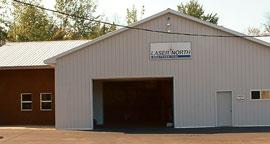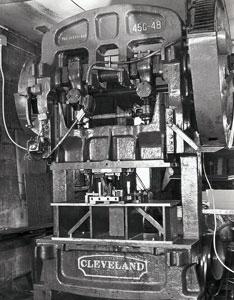Contributing Writer
- FMA
- The Fabricator
- FABTECH
- Canadian Metalworking
Categories
- Additive Manufacturing
- Aluminum Welding
- Arc Welding
- Assembly and Joining
- Automation and Robotics
- Bending and Forming
- Consumables
- Cutting and Weld Prep
- Electric Vehicles
- En Español
- Finishing
- Hydroforming
- Laser Cutting
- Laser Welding
- Machining
- Manufacturing Software
- Materials Handling
- Metals/Materials
- Oxyfuel Cutting
- Plasma Cutting
- Power Tools
- Punching and Other Holemaking
- Roll Forming
- Safety
- Sawing
- Shearing
- Shop Management
- Testing and Measuring
- Tube and Pipe Fabrication
- Tube and Pipe Production
- Waterjet Cutting
Industry Directory
Webcasts
Podcasts
FAB 40
Advertise
Subscribe
Account Login
Search
Live or die making tools
Tool and die shop scraps its business model to remain successful
- By Stephanie Vaughan
- December 12, 2006
- Article
- Shop Management

In a state of transition, the Niemela family business still bears its former tool and die name—NTE for Northern Tool & Engineering—and Laser North, the name of its new, repositioned company.
Leo Niemela's business style is a product of his upbringing. Niemela recalled his grandfather's most influential teaching when he described the day his mom and her sister said they were going into town to go shopping. Immediately Niemela's grandfather made other plans for them.
"You don't go to town to buy things. You go to town to sell things—and then you buy something," Niemela's grandfather said before loading his mother and aunt up with rutabagas to peddle.
Niemela chuckled as he remembered his mom's plan to sell the rutabagas: She and her sister would sit outside the busiest tavern in town and ask the men as they left if they'd like to buy any rutabagas.
"Farmers and lumberjacks went home with their jackets full of rutabagas," Niemela said, laughing.
Family stories like this laid a foundation for Niemela's business—one he's not ready to retire from yet. Unfortunately, a downturn in the tool and die industry recently shook his family business's foundation.
The Beginning of an Adventure
Niemela was born and raised in Michigan's Upper Peninsula. One of 10 siblings, he grew up on a farm and learned to use machinist tools at age 13.
A young man at the onset of World War II, Niemela traveled downstate to attend the Henry Ford Trade School in Detroit, and then worked in a tool and die shop for eight years. While in his 20s, he opened his own shop in a 1-1/2-car garage. As Niemela's tool and die shop grew, he rented a bigger building and hired a staff. He expanded the company one more time before retiring at age 40 from that business to run a dairy farm.
While working in a hayfield one day, Niemela was approached by a man in a suit who told him that Ford Motor Co. wanted him to open up a tool and die shop in the U.P.
That was the end of his retirement and the beginning of his Baraga, Mich., family business, Northern Tool & Engineering.
Over the years Northern Tool built progressive dies; draw dies; forming, piercing, and cutoff dies; tools; fixtures; and jigs. The company also offered production stamping and light fabrication work, eventually performing a significant amount of aluminum fabrication.

Removing presses like this one from Northern Tool was a challenge, both logistically and emotionally. Leo Niemela, a founding company owner, has specialized in tool and die for 50 years.
For Niemela, a tool- and diemaker for 50 years now, running this company with his family was a good way to make a living.
That is, until the early '80s, when tool and die started to decline.
To deal with the slump in the tool and die industry, Northern Tool & Engineering developed and produced proprietary products such as the Air Check, an air vending machine, and the Wheel Buff, an automatic rim cleaning system.
But even with its fabrication services and the products it introduced into the marketplace, Northern Tool still needed help.
So a year ago Niemela, with co-owners Carol Ketola and Leo's son Mark—all of whom were a part of Northern Tool from its beginning—made the hardest business decision yet: to exit the tool and die industry completely.
Options for Growth
Northern Tool's objective was simple: Remain successful and grow the business. Its owners knew that staying in tool and die wasn't going to achieve this objective.
In considering the company's options, the owners first thought about going into machining, but this didn't make enough sense for an area already populated with several machine shops.
"Machining centers are pretty common—we wanted a niche that no one else had," Leo said.
Next they considered specializing in waterjet services. Then after more consideration and shopping around for other technologies, Leo, Mark, and Ketola started investigating lasers seriously.
"The more we looked at it, the more we liked it," Mark said.
Once the decision was made, there was no turning back for the company, and its transformation was quick.
Removing the company's tool and die equipment was no small feat. At the time Northern Tool was using:
- Three surface grinders, two with manual feed and one with power feed.
- Two Bridgeport mills with DRO and power feed.
- A 20-inch Gould & Eberhardt shaper.
- Eight stamping presses from 35 to 135 tons.
- A 14-in. South Bend lathe.
- Four drill presses.
- Two radial drills.
- Two belt sanders.
- A buffing jack.
- Two cutoff saws, one with and one without automatic feed.
- An upright band saw.
- A sandblasting cabinet.
- A paint booth with an over- head conveyor.
- Forty-foot multishelf die racks.
- Die rails with chain falls.
The logistics, time, and effort to remove the equipment physically were difficult enough; another difficulty was the emotional aspect.
One of the presses that had to be removed was a 135-ton Toledo double-crank straight-side press that almost touched the ceiling and required two machines to move. Sending this press out the door was particularly difficult.
"It was really sad," Mark said.
"It was like watching a funeral," Leo added.
From Growing Pains to Growing Customer Base
The challenges continued as Northern Tool moved forward with its plan to reorganize and reposition the company with a new name, Laser North, and a new set of services to offer.
"It was a big change, a big challenge, and a big investment. It was a huge step all at one time to get rid of the old equipment and get the new equipment in," said Mark, adding that three semitrailer loads of equipment arrived simultaneously just for the new Mitsubishi laser.
To add to the company's repositioning pains, business started coming in even before employees knew how to use their new equipment: a laser, a press brake, and forklifts. One such customer was Terex Handlers, Baraga, Mich., which manufactures rough terrain telescopic material handlers as part of Westport, Conn.-based Terex Corp.
"Terex was ready for parts before we even knew how to use the equipment," Mark said.

Hanging on an office wall are reminders of the parts Northern Tool& Engineering used to make in its tool and die days.
Workers needed to learn how to use the laser, and ideally, Mark said, they would have gone to Chicago first to receive training. However, because their training needed to be rescheduled several times, the operators first got a crash course during the laser's installation.
After a couple of months of working with the equipment on their own and troubleshooting remotely with Mitsubishi, operators finally completed formal training.
Today Laser North performs significant sheet metal jobs for Terex, supplying 12-gauge engine enclosure assemblies, assorted frame parts, and special prototype parts. The company employs seven workers and runs lights-out.
Now that the company has gotten through its learning curve and started publicizing its new services, Mark said he can see what repositioning has helped to accomplish.
"It's opened a lot of doors for us. We're getting work from farther and farther away," he said.
Currently the company laser-cuts and forms parts for customers more than 100 miles east of its U.P. facility and is continuing to grow its customer base geographically.
Customers include heavy equipment manufacturers, job shops, and engineering firms.
The company also is networking through MFG.com, an Internet sourcing service, and is quoting work across North America.
While its fabrication and die work mostly is in its past, the company still bends steel—but now operators use a CNC press brake for those applications.
Although it's been a significant change, to say the least, the Niemela family knows it made the right choice and is looking toward the future.

Laser cutting was the best technology choice to specialize in for the area, according to Leo Niemela. Today the company serves companies more than 100 miles away and is still expanding its reach and customer base.
"It's been a heart transplant," Mark said. "We're just beginning to grow. We have been occupied the past year or so with installing and getting to know our new equipment, while still keeping our customers happy and adding new ones.
"It's a new game, but we're excited about it."
About the Author

Related Companies
subscribe now

The Fabricator is North America's leading magazine for the metal forming and fabricating industry. The magazine delivers the news, technical articles, and case histories that enable fabricators to do their jobs more efficiently. The Fabricator has served the industry since 1970.
start your free subscription- Stay connected from anywhere

Easily access valuable industry resources now with full access to the digital edition of The Fabricator.

Easily access valuable industry resources now with full access to the digital edition of The Welder.

Easily access valuable industry resources now with full access to the digital edition of The Tube and Pipe Journal.
- Podcasting
- Podcast:
- The Fabricator Podcast
- Published:
- 04/16/2024
- Running Time:
- 63:29
In this episode of The Fabricator Podcast, Caleb Chamberlain, co-founder and CEO of OSH Cut, discusses his company’s...
- Trending Articles
AI, machine learning, and the future of metal fabrication

Employee ownership: The best way to ensure engagement

Steel industry reacts to Nucor’s new weekly published HRC price

Dynamic Metal blossoms with each passing year

Metal fabrication management: A guide for new supervisors

- Industry Events
16th Annual Safety Conference
- April 30 - May 1, 2024
- Elgin,
Pipe and Tube Conference
- May 21 - 22, 2024
- Omaha, NE
World-Class Roll Forming Workshop
- June 5 - 6, 2024
- Louisville, KY
Advanced Laser Application Workshop
- June 25 - 27, 2024
- Novi, MI



























